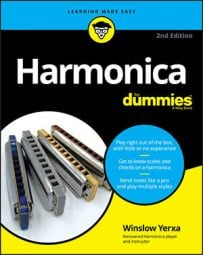With the following information, you can become a harp surgeon (though you may not get to play one on TV). The following list outlines the symptoms and gives you the most likely diagnoses to bring a harp back to good health.
-
The note won’t play at all. When a note just won’t play, one of four causes may be to blame. Here they are from the most trivial (and easy to fix) to the most serious and difficult:
-
Something is obstructing the free movement of the reed.
-
The harp may be assembled incorrectly.
-
The reed action may be set incorrectly.
-
The reed may be dead and ready to break off. In this case, you should send the harp to your boneyard of spare parts.
-
-
The note plays, sort of, but you hear a funny buzz. Buzzing may be caused by debris, but it also may mean that the reed is out of alignment and is hitting the sides of its slot.
-
You get a high-pitched squeal when you bend — or sometimes when you just play the note. This is caused by torsional vibration — when a reed rocks from side to side. Careful attention to your breathing and the formation of your mouth, tongue, and throat can help, but you can also address it by dabbing a little nail polish or beeswax in the corners at the base of the reed.
Some players attach a tiny strip of adhesive tape or a drop of glue to the middle of the reed near the base to dampen torsional vibrations.
-
A note takes too much air to play. The harp may not be properly assembled. Specifically, the bolt closest to that reed may be loose. If this fix doesn’t help, the reed action also may be set too high.
-
It takes too much air to play the harp, and the notes sound weak. The reedplates may not be securely fastened to the comb or the comb and reedplates may not be fitting together.
-
The note sounds out of tune or makes a noise like a moaning cow. If you’re a novice player, you may have this experience with one of the bendable notes, such as:
-
Draw 1, 2, 3, 4, 5, or 6 — but especially Draw 2 or Draw 3
-
Blow 7, 8, 9, or 10 — most often Blow 8
You may be pulling the pitch down inadvertently. Try playing a chord that includes the holes on both sides of the offending note. If the chord sounds good and the notes are in tune, then you need to work on your breathing technique. If the note still sounds out of tune, you can tune a harmonica reed to the correct pitch with tuning tools and an electronic tuner.
-
-
The note sticks — it doesn’t play right away. This problem indicates that the reed gap is too low and needs to be raised.
-
The note stopped playing and a little strip of metal fell out. The reed has fatigued and broken. You can purchase a new harp or a new set of reedplates (if the manufacturer offers them). Or check your harmonica boneyard to see whether you have a matching reedplate that’s in good shape. In any case, don’t throw the harp away. Keep it for spare parts.

